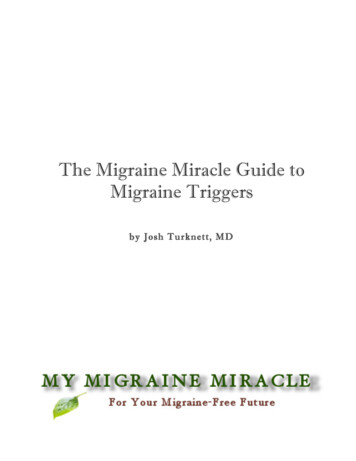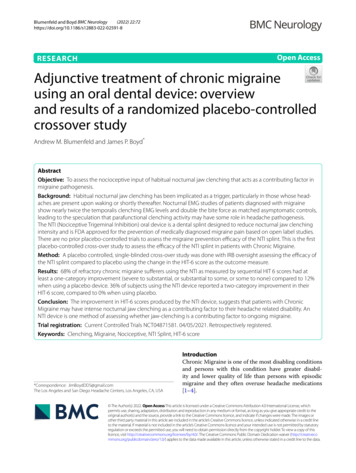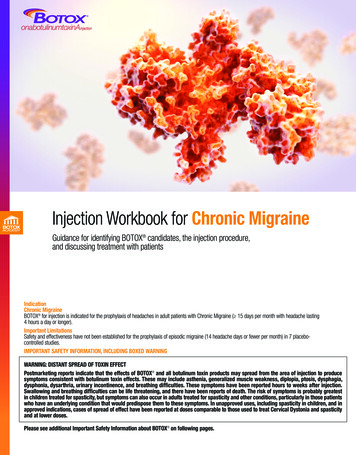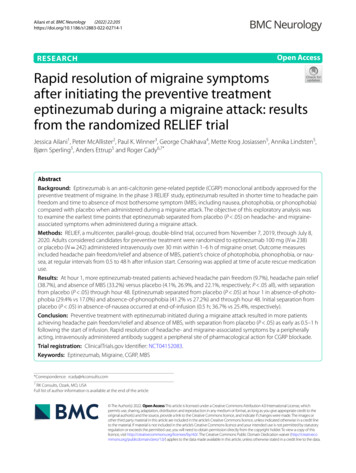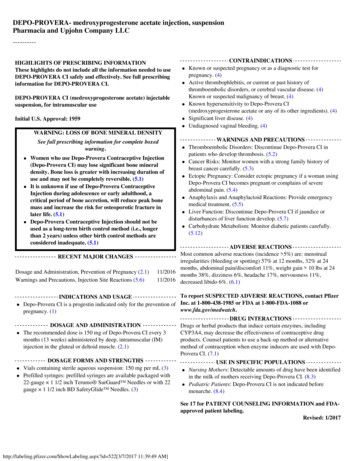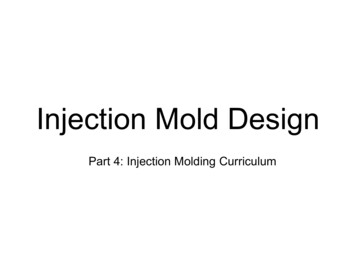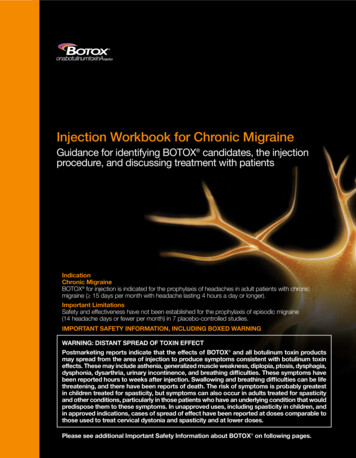
Transcription
Injection Workbook for Chronic MigraineGuidance for identifying BOTOX candidates, the injectionprocedure, and discussing treatment with patientsIndicationChronic MigraineBOTOX for injection is indicated for the prophylaxis of headaches in adult patients with chronicmigraine ( 15 days per month with headache lasting 4 hours a day or longer).Important LimitationsSafety and effectiveness have not been established for the prophylaxis of episodic migraine(14 headache days or fewer per month) in 7 placebo-controlled studies.IMPORTANT SAFETY INFORMATION, INCLUDING BOXED WARNINGWARNING: DISTANT SPREAD OF TOXIN EFFECTPostmarketing reports indicate that the effects of BOTOX and all botulinum toxin productsmay spread from the area of injection to produce symptoms consistent with botulinum toxineffects. These may include asthenia, generalized muscle weakness, diplopia, ptosis, dysphagia,dysphonia, dysarthria, urinary incontinence, and breathing difficulties. These symptoms havebeen reported hours to weeks after injection. Swallowing and breathing difficulties can be lifethreatening, and there have been reports of death. The risk of symptoms is probably greatestin children treated for spasticity, but symptoms can also occur in adults treated for spasticityand other conditions, particularly in those patients who have an underlying condition that wouldpredispose them to these symptoms. In unapproved uses, including spasticity in children, andin approved indications, cases of spread of effect have been reported at doses comparable tothose used to treat cervical dystonia and spasticity and at lower doses.Please see additional Important Safety Information about BOTOX on following pages.
IntroductionThis workbook is designed to help you learn and apply the proven BOTOX Injection Paradigm.It also contains information to help injectors identify appropriate BOTOX candidates, understandprocedure-related anatomy, manage patient expectations, and integrate the procedure intothe practice.Reference material accompanying this workbook:Reconstitution pocket guideATION (continued)to BOTOX for injection are discussedsections: Spread of Toxin Effectdverse Reactions With Unapprovedons); Hypersensitivity Reactions (seeand Precautions); Increased RiskWith Pre-Existing Neuromuscularecautions); and Dysphagia andings and Precautions).dverse reactions following injectioninclude neck pain (9%), headachee (4%), muscular weakness (4%),bronchitis (3%), injection-site pain), myalgia (3%), facial paresis (2%),spasms (2%).eports of death, sometimesumonia, and/or other significantatment with botulinum toxin. Therese events involving the cardiovascularnd myocardial infarction, some withpatients had risk factors includingct relationship of these events to thet been established.nd aminoglycosides or other agentstransmission (eg, curare-likeformed with caution as the effectUse of anticholinergic drugs afterpotentiate systemic anticholinergicing different botulinum neurotoxinthin several months of each other iscular weakness may be exacerbatedtulinum toxin prior to the resolutionministered botulinum toxin. Excessiveated by administration of a muscletration of BOTOX .Prescribing Information includingGuide.k DW, Aurora SK, Turkel CC, Binder WJ. Methodr chronic migraine: a safe, well-tolerated, andon the PREEMPT clinical program. Headache.scribing Information, January 2016.Allergan. All rights reserved. All trademarks are the propertyrespective owners. BOTOXMedical.com/ChronicMigraine4-BOTOX APC54GS16 160853Reconstitution/InjectionPocket CardThis pocket card is a reference guide for BOTOX (onabotulinumtoxinA)injection sites for Chronic Migraine patients. The reconstitutionmaterials, dilution table, and Injection Paradigm are highlighted forquick reference.IndicationChronic MigraineBOTOX for injection is indicated for the prophylaxis of headachesin adult patients with chronic migraine ( 15 days per month withheadache lasting 4 hours a day or longer).Important LimitationsSafety and effectiveness have not been established for the prophylaxisof episodic migraine (14 headache days or fewer per month) in 7placebo-controlled studies.IMPORTANT SAFETY INFORMATION, INCLUDING BOXED WARNINGWARNING: DISTANT SPREAD OF TOXIN EFFECTPostmarketing reports indicate that the effects of BOTOX and allbotulinum toxin products may spread from the area of injection toproduce symptoms consistent with botulinum toxin effects. Thesemay include asthenia, generalized muscle weakness, diplopia, ptosis,dysphagia, dysphonia, dysarthria, urinary incontinence, and breathingdifficulties. These symptoms have been reported hours to weeks afterinjection. Swallowing and breathing difficulties can be life threatening,and there have been reports of death. The risk of symptoms is probablygreatest in children treated for spasticity, but symptoms can also occurin adults treated for spasticity and other conditions, particularly inthose patients who have an underlying condition that would predisposethem to these symptoms. In unapproved uses, including spasticity inchildren, and in approved indications, cases of spread of effect havebeen reported at doses comparable to those used to treat cervicaldystonia and spasticity and at lower doses.Please see additional ImportantSafety Information aboutBOTOX inside.IMPORTANT SAFETY INFORMATION (continued)CONTRAINDICATIONSBOTOX is contraindicated in the presence of infection at the proposed injection site(s) and in individualswith known hypersensitivity to any botulinum toxin preparation or to any of the components inthe formulation.WARNINGS AND PRECAUTIONSLack of Interchangeability Between Botulinum Toxin ProductsThe potency Units of BOTOX are specific to the preparation and assay method utilized. Theyare not interchangeable with other preparations of botulinum toxin products and, therefore,Units of biological activity of BOTOX cannot be compared to nor converted into Units of anyother botulinum toxin products assessed with any other specific assay method.Spread of Toxin EffectSee Boxed Warning.2No definitive serious adverse event reports of distant spread of toxin effect associated with BOTOX forchronic migraine at the labeled dose have been reported.
Table of contentsLEARN ABOUT THE PATIENTIdentifying BOTOX candidates . . . . . . . . . . . . . . . . . . . . . . . . . . . . . . . . . . . . . . . . . . . . . . . . . . . . . . . . . . . . . . . . . . . . . . . . . . . . . . . . . . . . . . . . . . . . . . . . . . . . . . . . . . . . . . . . . . . . . . . . . . . . 4LEARN ABOUT THE PROCEDUREPREEMPT* Paradigm overview. . . . . . . . . . . . . . . . . . . . . . . . . . . . . . . . . . . . . . . . . . . . . . . . . . . . . . . . . . . . . . . . . . . . . . . . . . . . . . . . . . . . . . . . . . . . . . . . . . . . . . . . . . . . . . . . . . . . . . . . . . . . . 7General injection considerations. . . . . . . . . . . . . . . . . . . . . . . . . . . . . . . . . . . . . . . . . . . . . . . . . . . . . . . . . . . . . . . . . . . . . . . . . . . . . . . . . . . . . . . . . . . . . . . . . . . . . . . . . . . . . . . . . . . . . . . . . . 8Anterior injections . . . . . . . . . . . . . . . . . . . . . . . . . . . . . . . . . . . . . . . . . . . . . . . . . . . . . . . . . . . . . . . . . . . . . . . . . . . . . . . . . . . . . . . . . . . . . . . . . . . . . . . . . . . . . . . . . . . . . . . . . . . . . . . . . . . . . . . . . . . . . . . . . . . . . . 10— Anatomy of the face and head . . . . . . . . . . . . . . . . . . . . . . . . . . . . . . . . . . . . . . . . . . . . . . . . . . . . . . . . . . . . . . . . . . . . . . . . . . . . . . . . . . . . . . . . . . . . . . . . . . . . . . . . . . . . . . . . . . . . . . . . . . 10— Corrugator injections . . . . . . . . . . . . . . . . . . . . . . . . . . . . . . . . . . . . . . . . . . . . . . . . . . . . . . . . . . . . . . . . . . . . . . . . . . . . . . . . . . . . . . . . . . . . . . . . . . . . . . . . . . . . . . . . . . . . . . . . . . . . . . . . . . . . . . . . . . . . . 14— Procerus injection. . . . . . . . . . . . . . . . . . . . . . . . . . . . . . . . . . . . . . . . . . . . . . . . . . . . . . . . . . . . . . . . . . . . . . . . . . . . . . . . . . . . . . . . . . . . . . . . . . . . . . . . . . . . . . . . . . . . . . . . . . . . . . . . . . . . . . . . . . . . . . . . . . . . 16— Frontalis injections. . . . . . . . . . . . . . . . . . . . . . . . . . . . . . . . . . . . . . . . . . . . . . . . . . . . . . . . . . . . . . . . . . . . . . . . . . . . . . . . . . . . . . . . . . . . . . . . . . . . . . . . . . . . . . . . . . . . . . . . . . . . . . . . . . . . . . . . . . . . . . . . . . . 18— Temporalis injections . . . . . . . . . . . . . . . . . . . . . . . . . . . . . . . . . . . . . . . . . . . . . . . . . . . . . . . . . . . . . . . . . . . . . . . . . . . . . . . . . . . . . . . . . . . . . . . . . . . . . . . . . . . . . . . . . . . . . . . . . . . . . . . . . . . . . . . . . . . . . . 20Posterior injections. . . . . . . . . . . . . . . . . . . . . . . . . . . . . . . . . . . . . . . . . . . . . . . . . . . . . . . . . . . . . . . . . . . . . . . . . . . . . . . . . . . . . . . . . . . . . . . . . . . . . . . . . . . . . . . . . . . . . . . . . . . . . . . . . . . . . . . . . . . . . . . . . . . . 22— Anatomy of the neck and head . . . . . . . . . . . . . . . . . . . . . . . . . . . . . . . . . . . . . . . . . . . . . . . . . . . . . . . . . . . . . . . . . . . . . . . . . . . . . . . . . . . . . . . . . . . . . . . . . . . . . . . . . . . . . . . . . . . . . . . . . 22— Occipitalis injections . . . . . . . . . . . . . . . . . . . . . . . . . . . . . . . . . . . . . . . . . . . . . . . . . . . . . . . . . . . . . . . . . . . . . . . . . . . . . . . . . . . . . . . . . . . . . . . . . . . . . . . . . . . . . . . . . . . . . . . . . . . . . . . . . . . . . . . . . . . . . . . 24— Cervical paraspinal injections . . . . . . . . . . . . . . . . . . . . . . . . . . . . . . . . . . . . . . . . . . . . . . . . . . . . . . . . . . . . . . . . . . . . . . . . . . . . . . . . . . . . . . . . . . . . . . . . . . . . . . . . . . . . . . . . . . . . . . . . . . . . . 26— Trapezius injections . . . . . . . . . . . . . . . . . . . . . . . . . . . . . . . . . . . . . . . . . . . . . . . . . . . . . . . . . . . . . . . . . . . . . . . . . . . . . . . . . . . . . . . . . . . . . . . . . . . . . . . . . . . . . . . . . . . . . . . . . . . . . . . . . . . . . . . . . . . . . . . . 28Adverse events . . . . . . . . . . . . . . . . . . . . . . . . . . . . . . . . . . . . . . . . . . . . . . . . . . . . . . . . . . . . . . . . . . . . . . . . . . . . . . . . . . . . . . . . . . . . . . . . . . . . . . . . . . . . . . . . . . . . . . . . . . . . . . . . . . . . . . . . . . . . . . . . . . . . . . . . . . . . 30Patient assessment before injection . . . . . . . . . . . . . . . . . . . . . . . . . . . . . . . . . . . . . . . . . . . . . . . . . . . . . . . . . . . . . . . . . . . . . . . . . . . . . . . . . . . . . . . . . . . . . . . . . . . . . . . . . . . . . . . . 32LEARN ABOUT SETTING UP THE PRACTICETips to efficiently adopt BOTOX treatment in the office . . . . . . . . . . . . . . . . . . . . . . . . . . . . . . . . . . . . . . . . . . . . . . . . . . . . . . . . . . . . . . . . . . . . . . 36Insurance policy requirements . . . . . . . . . . . . . . . . . . . . . . . . . . . . . . . . . . . . . . . . . . . . . . . . . . . . . . . . . . . . . . . . . . . . . . . . . . . . . . . . . . . . . . . . . . . . . . . . . . . . . . . . . . . . . . . . . . . . . . . . . . . . 38Resources available to patients and injectors . . . . . . . . . . . . . . . . . . . . . . . . . . . . . . . . . . . . . . . . . . . . . . . . . . . . . . . . . . . . . . . . . . . . . . . . . . . . . . . . . . . . . . . . . . . . . . . . 40Helpful phone numbers and websites . . . . . . . . . . . . . . . . . . . . . . . . . . . . . . . . . . . . . . . . . . . . . . . . . . . . . . . . . . . . . . . . . . . . . . . . . . . . . . . . . . . . . . . . . . . . . . . . . . . . . . . . . . . . . 44*PREEMPT Phase 3 REsearch Evaluating Migraine Prophylaxis Therapy.IMPORTANT SAFETY INFORMATION (continued)WARNINGS AND PRECAUTIONS (continued)Serious Adverse Reactions With Unapproved UseSerious adverse reactions, including excessive weakness, dysphagia, and aspiration pneumonia, withsome adverse reactions associated with fatal outcomes, have been reported in patients who receivedBOTOX injections for unapproved uses. In these cases, the adverse reactions were not necessarily relatedto distant spread of toxin, but may have resulted from the administration of BOTOX to the site of injectionand/or adjacent structures. In several of the cases, patients had pre-existing dysphagia or other significantdisabilities. There is insufficient information to identify factors associated with an increased risk for adversereactions associated with the unapproved uses of BOTOX . The safety and effectiveness of BOTOX forunapproved uses have not been established.Please see additional Important Safety Information about BOTOX on following pages.3
Identifying BOTOX candidatesPractical clinical criteria for Chronic Migraine diagnosis1,215or more headachedays per month8 Headaches last4hours or more per dayor more headachedays are migraine days With or without medication overuse2Focus on headache days vs migraine attacks Not all days need to be associated with migraine2 Days when headaches were successfully treated with migraine-specific acute medications(eg, triptans) are also considered headache days2 Ask about headache-free days if patient cannot recall number of actual headache days4IMPORTANT SAFETY INFORMATION (continued)WARNINGS AND PRECAUTIONS (continued)Hypersensitivity ReactionsSerious and/or immediate hypersensitivity reactions have been reported. These reactions includeanaphylaxis, serum sickness, urticaria, soft-tissue edema, and dyspnea. If such a reaction occurs, furtherinjection of BOTOX should be discontinued and appropriate medical therapy immediately instituted. Onefatal case of anaphylaxis has been reported in which lidocaine was used as the diluent, and consequentlythe causal agent cannot be reliably determined.
Considerations when evaluating treatment plansPrevention may be an important part of a Chronic Migraine management plan. Aside from ensuringadequate prevention, a management plan may include optimizing acute medication use/limitingmedication overuse, addressing comorbid conditions, and adjusting patient lifestyles (eg, diet, exercise,curbing caffeine overuse).3,4Treatment planning begins with a thorough history, which can include inquiry around these topics:Is the patientusing more acutemedications thanrecommended?Is the patientrespondingappropriatelyto acutemedications?Is the patientmeetingtreatmentgoals?Has the patientfollowed theprescribedpreventiveregimen?Are therecontraindicationsto sometreatmentoptions?Revisit appropriate Chronic Migraine patients’management plans with BOTOX treatment in mindA history of preventive use5Chronic Migraine patientshave tried3.9preventive treatmentson average (n 493)5IMPORTANT SAFETY INFORMATION (continued)WARNINGS AND PRECAUTIONS (continued)Increased Risk of Clinically Significant Effects With Pre-Existing Neuromuscular DisordersIndividuals with peripheral motor neuropathic diseases, amyotrophic lateral sclerosis, or neuromuscularjunction disorders (eg, myasthenia gravis or Lambert-Eaton syndrome) should be monitored when givenbotulinum toxin. Patients with neuromuscular disorders may be at increased risk of clinically significanteffects including generalized muscle weakness, diplopia, ptosis, dysphonia, dysarthria, severe dysphagia,and respiratory compromise from therapeutic doses of BOTOX (see Warnings and Precautions).Please see additional Important Safety Information about BOTOX on following pages.5
Identifying BOTOX candidates (continued)As part of the evaluation, documenting symptoms for a Chronic Migraine diagnosis is important.When patients can understand the symptoms of their condition, they may feel less frustrated andmore open to treatment options.Headache frequencyand durationEvaluate both headache days andheadache-free daysHeadache severityAsk about symptoms and intensity, which mayshed light on headache severity 6Headache impactUncover how headache affects daily activitiesto avoid a patient minimizing symptoms6Migraine featuresDiscuss photophobia, phonophobia, pulsating quality, pain,aggravation with activity, headache location, nausea, and vomiting7Greater disability correlates with headache frequency8Patients with Chronic Migraine are significantly more likely to be severely disabled than thosewith episodic migraine (64.3% vs 43.2% Migraine Disability Assessment [MIDAS] grade IV).6IMPORTANT SAFETY INFORMATION (continued)WARNINGS AND PRECAUTIONS (continued)Dysphagia and Breathing DifficultiesTreatment with BOTOX and other botulinum toxin products can result in swallowing or breathingdifficulties. Patients with pre-existing swallowing or breathing difficulties may be more susceptible tothese complications. In most cases, this is a consequence of weakening of muscles in the area ofinjection that are involved in breathing or oropharyngeal muscles that control swallowing or breathing(see Boxed Warning).
! !!PREEMPT Paradigm overviewThe PREEMPT Paradigm is based on 10 years of study to assess patient type, muscleselection, dose, and treatment interval.9-17155 1551215512 311231 31UNITSUNITSWEEKSUNITSWEEKSSITESWEEKSSITESPROVEN DOSE155 Units1Summary of dose by area1PROVEN SCHEDULETrial of 2 treatments, 12 weeksapart, with further re-treatmentevery 12 weeks1,*SITESPROVEN SITES31 sites across7 specific head andneck muscle areas1MUSCLE AREARECOMMENDED DOSE/NUMBER OF SITESCorrugator10 Units divided between 2 sitesProcerus5 Units in 1 siteFrontalis20 Units divided between 4 sitesTemporalis40 Units divided between 8 sitesOccipitalis30 Units divided between 6 sitesCervical paraspinal20 Units divided between 4 sitesTrapezius30 Units divided between 6 sitesTOTAL DOSE155 Units† divided between 31 sites*Re-treatment after 24 weeks should be determined per clinician’s discretion.†Document and discard the 45-Unit wastage.The following section provides a step-by-step overview of the PREEMPT Paradigm for BOTOX .Departures from the approved paradigm may lead to efficacy results and adverse events different fromthose seen in the clinical trials.IMPORTANT SAFETY INFORMATION (continued)WARNINGS AND PRECAUTIONS (continued)Human Albumin and Transmission of Viral DiseasesThis product contains albumin, a derivative of human blood. Based on effective donor screening andproduct manufacturing processes, it carries an extremely remote risk for transmission of viral diseases.A theoretical risk for transmission of Creutzfeldt-Jakob disease (CJD) is also considered extremelyremote. No cases of transmission of viral diseases or CJD have ever been reported for albumin.Please see additional Important Safety Information about BOTOX on following pages.7
General injection considerationsSTANDARD METHODS REGARDLESS OF AREA For each injection, the injection volume will be 0.1 mL (equivalent to 5 Units)1 Consider injecting in the most superficial aspect of the muscle Evaluate the anatomy, including relevant function and the effects of treatment on these muscles(eg, weakening) Recognize unique anatomy, as no 2 patients are alike; focus on the muscle, not measurements, toadjust for individual anatomical variations Consider location, depth, and angle carefully, as the site of medication delivery may be differentfrom the needle insertion point– Injection sites depicted in diagrams represent delivery point of the medicationBEFORE INJECTION Examine the patient to identify unique anatomy and any muscle weakness or pain/tenderness– Visually inspect the muscle– Ask the patient to activate the muscle– Palpate the muscle Verify the needle is securely fastened to the injection syringe Line up the bevel of the needle with the gradations on the syringe so the bevel is facing upward;this will help you more easily orient the bevel of the needle when injectingIMPORTANT SAFETY INFORMATION (continued)ADVERSE REACTIONSThe following adverse reactions to BOTOX for injection are discussed in greater detail in the followingsections: Spread of Toxin Effect (see Boxed Warning); Serious Adverse Reactions With UnapprovedUse (see Warnings and Precautions); Hypersensitivity Reactions (see Contraindications and Warningsand Precautions); Increased Risk of Clinically Significant Effects With Pre-Existing NeuromuscularDisorders (see Warnings and Precautions); and Dysphagia and Breathing Difficulties (see Warningsand Precautions).Chronic MigraineThe most frequently reported adverse reactions following injection of BOTOX for chronic migraine vsplacebo include, respectively: neck pain (9% vs 3%), headache (5% vs 3%), eyelid ptosis (4% vs 1%),migraine (4% vs 3%), muscular weakness (4% vs 1%), musculoskeletal stiffness (4% vs 1%), bronchitis(3% vs 2%), injection-site pain (3% vs 2%), musculoskeletal pain (3% vs 1%), myalgia (3% vs 1%), facialparesis (2% vs 0%), hypertension (2% vs 1%), and muscle spasms (2% vs 1%).8Severe worsening of migraine requiring hospitalization occurred in approximately 1% of BOTOX treatedpatients in study 1 and study 2, usually within the first week after treatment, compared with 0.3% ofplacebo-treated patients.
DURING INJECTION Inject on 1 side first for bilateral injections, then proceed to the other side and repeat at all thespecified sites Consider changing needles frequently to reduce patient discomfort; consider using 1 needle perarea or changing every 4 to 6 sites Inject with the bevel up, pointing away from the skin It may be helpful to hold the hub of the needle with 1 hand to ensure the needle does not twist– Push the plunger with the other hand to administer the medication Aspirate to ensure no blood return Target the muscle—The needle should be inserted through the epidermis/dermis layer, whichmay feel more rigid when penetrated. The injection should be given just when there is a decreasein resistance, avoiding the periosteum. This decrease in resistance may be subdermal,not intramuscularFigure 1*Example of procerusinjection. Note the angle usedto avoid the periosteum andtarget the muscle (Figure 1).†*This is a hypothetical patient.†Muscles and anatomical structures shown for anatomical reference only.IMPORTANT SAFETY INFORMATION (continued)ADVERSE REACTIONS (continued)Post Marketing ExperienceThere have been spontaneous reports of death, sometimes associated with dysphagia, pneumonia,and/or other significant debility or anaphylaxis, after treatment with botulinum toxin. There have alsobeen reports of adverse events involving the cardiovascular system, including arrhythmia and myocardialinfarction, some with fatal outcomes. Some of these patients had risk factors including cardiovasculardisease. The exact relationship of these events to the botulinum toxin injection has not been established.Please see additional Important Safety Information about BOTOX on following pages.9
Anterior injections*Anatomy of the face and headThis section will highlight muscle area anatomy to provide additional context for the anteriorinjection sites.FrontalisOriginates from the epicranialaponeurosis, and attaches distallyto the skin of the foreheadand eyebrow.18CorrugatorAttaches to the nasal-frontal bonemedially and the skin of theeyebrow laterally.18,19ProcerusOriginates from the aponeuroticfascia of the nose and inserts intothe glabellar skin.18*Muscles and anatomical structures shown for anatomical reference only.IMPORTANT SAFETY INFORMATION (continued)DRUG INTERACTIONSCo-administration of BOTOX and aminoglycosides or other agents interfering with neuromusculartransmission (eg, curare-like compounds) should only be performed with caution as the effect of thetoxin may be potentiated. Use of anticholinergic drugs after administration of BOTOX may potentiatesystemic anticholinergic effects. The effect of administering different botulinum neurotoxin products atthe same time or within several months of each other is unknown. Excessive neuromuscular weaknessmay be exacerbated by administration of another botulinum toxin prior to the resolution of the effects of apreviously administered botulinum toxin. Excessive weakness may also be exaggerated by administrationof a muscle relaxant before or after administration of BOTOX .10Please see accompanying full Prescribing Information including Boxed Warning andMedication Guide.
TemporalisOriginates from the temporal fossaand deep layer of the temporalfascia, and inserts into the top andmedial surface of the coronoidprocess of the mandible.18Interrelationship between muscles Corrugator muscle fibers and frontalis muscle fibers interdigitate in the region of the medial browwhere the corrugator inserts into skin On the corrugator’s medial aspect, it is deep to both the procerus muscle and the superficial,thinned-out frontalis muscle fibersBecause of the close proximity of these muscles, pay close attention to the depth and angleof the needle. There can be a difference between the insertion point and where the medicationis ultimately delivered.IndicationChronic MigraineBOTOX for injection is indicated for the prophylaxis of headaches in adult patients with chronic migraine( 15 days per month with headache lasting 4 hours a day or longer).Important LimitationsSafety and effectiveness have not been established for the prophylaxis of episodic migraine(14 headache days or fewer per month) in 7 placebo-controlled studies.Please see Important Safety Information including Boxed Warning about BOTOX on following pages.11
Anterior injections (continued)*Functional anatomyThis section will highlight the functional anatomy of each anterior injection site, which may be importantto consider when injecting.The frontalis muscle is a browelevator, pulling the brow upward.18Weakening of this muscle mayresult in brow ptosis.Activating the frontalis createstransverse lines on the forehead(Figure 2).18Figure 2The corrugator muscle is abrow depressor, pulling the browdownward.18 Weakening of thismuscle may elevate the brow.Activating the corrugator createsvertical lines between the brow(Figure 3).18Figure 3*Muscles and anatomical structures shown for anatomical reference only.IMPORTANT SAFETY INFORMATION, INCLUDING BOXED WARNING12WARNING: DISTANT SPREAD OF TOXIN EFFECTPostmarketing reports indicate that the effects of BOTOX and all botulinum toxin productsmay spread from the area of injection to produce symptoms consistent with botulinum toxineffects. These may include asthenia, generalized muscle weakness, diplopia, ptosis, dysphagia,dysphonia, dysarthria, urinary incontinence, and breathing difficulties. These symptoms havebeen reported hours to weeks after injection. Swallowing and breathing difficulties can be lifethreatening, and there have been reports of death. The risk of symptoms is probably greatestin children treated for spasticity, but symptoms can also occur in adults treated for spasticityand other conditions, particularly in those patients who have an underlying condition that wouldpredispose them to these symptoms. In unapproved uses, including spasticity in children, andin approved indications, cases of spread of effect have been reported at doses comparable tothose used to treat cervical dystonia and spasticity and at lower doses.
Functional anatomy (continued)The procerus muscle drawsdown the medial aspect ofthe brow.18Activating the procerus creates atransverse ridge over the nose(Figure 4).18Figure 4†The temporalis is a masticatorymuscle. Clenching the teethactivates the temporalis and canhelp localize the muscle (Figure 5).18Figure 5†This is a hypothetical patient.IMPORTANT SAFETY INFORMATION (continued)CONTRAINDICATIONSBOTOX is contraindicated in the presence of infection at the proposed injection site(s) and in individualswith known hypersensitivity to any botulinum toxin preparation or to any of the components inthe formulation.WARNINGS AND PRECAUTIONSLack of Interchangeability Between Botulinum Toxin ProductsThe potency Units of BOTOX are specific to the preparation and assay method utilized. Theyare not interchangeable with other preparations of botulinum toxin products and, therefore,Units of biological activity of BOTOX cannot be compared to nor converted into Units of anyother botulinum toxin products assessed with any other specific assay method.Spread of Toxin EffectSee Boxed Warning.No definitive serious adverse event reports of distant spread of toxin effect associated with BOTOX forchronic migraine at the labeled dose have been reported.Please see additional Important Safety Information about BOTOX on following pages.13
Standard corrugator PREEMPT protocol*Dose1 5 Units (0.1 mL) in each site Total of 10 Units divided into2 sitesCorrugator muscle18,*Medial inferior edgeof the superior orbital rim18,*Injection site A About 1.5 cm ( 1 fingerbreadth)above the medial inferior edgeof the superior orbital rim (bonylandmark). This may vary basedon individual anatomyAACorrugator injection sites1*Muscles and anatomical structures shown for anatomical reference only.IMPORTANT SAFETY INFORMATION (continued)WARNINGS AND PRECAUTIONS (continued)Serious Adverse Reactions With Unapproved UseSerious adverse reactions, including excessive weakness, dysphagia, and aspiration pneumonia, withsome adverse reactions associated with fatal outcomes, have been reported in patients who receivedBOTOX injections for unapproved uses. In these cases, the adverse reactions were not necessarily relatedto distant spread of toxin, but may have resulted from the administration of BOTOX to the site of injectionand/or adjacent structures. In several of the c
A double-blind, randomized, placebo-controlled comparison of botulinum toxin type A injection sites and doses in the prevention of episodic migraine. Pain Med. 2007;8(6):478-485. 14. Relja M, Poole AC, Schoenen J, Pascual J, Lei X, Thompson C; for the European BoNTA Headache Study Group. A multicentre, double-blind, randomized, placebo-controlled,
